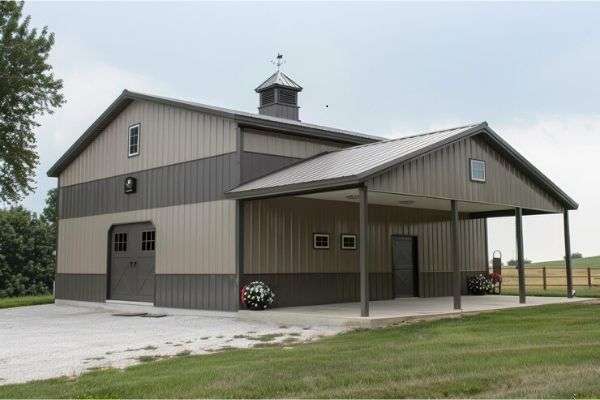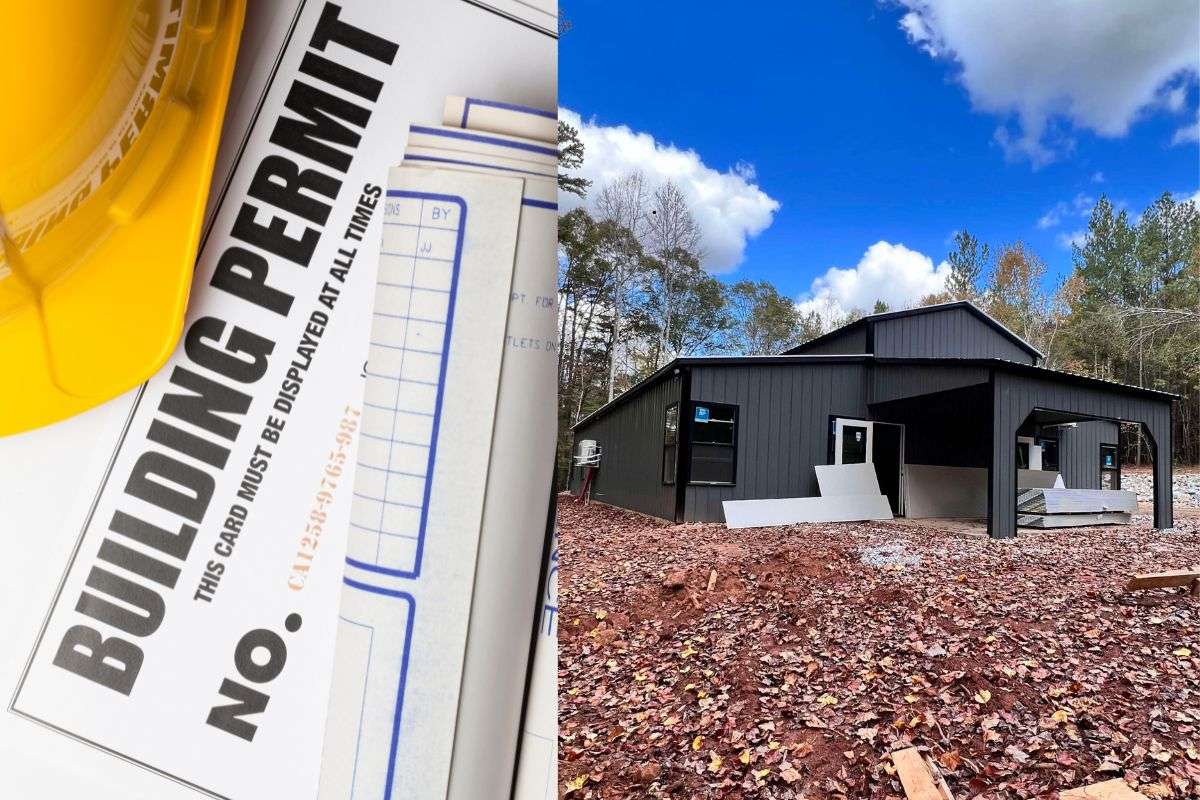A Barndominium is a smart way to build a comfortable and affordable home in the countryside. These barn-style homes offer space, durability, and flexibility—perfect for families wanting more from rural living. Before starting your project, it’s important to know which permits you’ll need. Zoning permits confirm the land is approved for building. You’ll also need building permits to meet safety and construction standards. Some areas may require plumbing, electrical, or septic permits too.
Barndominiums are often part of larger metal building projects, so checking local regulations is key. Skipping permits can lead to costly delays or legal issues. Always contact your local building office before starting. In this guide, we will explain what you’ll need before breaking ground.

What Is a Barndominium? Here’s the Simple Explanation
A barndominium combines the words “barn” and “condominium” into one creative home concept. The idea began over 30 years ago. Originally, it referred to residential developments that included horse facilities and single-family homes. Today, it describes barn-style buildings with built-in living spaces.
Modern barndominiums—often called “barndos”—come in many shapes and sizes. Most are built with strong steel frames. Some feature wood or stone on the outside to add rustic charm. Barndos usually include large, open floor plans and areas for storage, work, or hobbies.
Some barndominiums are old barns that have been remodeled into homes. Others are brand-new builds made just for hybrid living. Many include first-floor areas for business, farming, or workshops, with the home section attached or built above. This makes barndos a great choice for those who need flexible space.
Which Permits Are Required To Build a Barndominium?
Before starting construction on your barndominium, you’ll need several essential permits to ensure your project meets local laws, zoning regulations, and safety standards. Failing to secure these permits can result in serious delays, fines, or having to redo completed work—so it’s important to get it right from the beginning.
1. Zoning Permit
Start by confirming your land is zoned for residential or mixed-use development. Zoning permits verify that your structure is allowed on the property and complies with setback rules, height limits, and land use.
2. Building Permit
A building permit ensures that your barndominium’s structure complies with the local building code and construction standards. You’ll need to submit building plans for approval and schedule inspections during key phases of the build, such as the foundation, framing, and final construction.
3. Electrical Permit
Any installation of wiring, lighting, breaker boxes, or electrical panels requires an electrical permit. A licensed electrician is typically required for this type of work.
4. Plumbing Permit
If your barndominium includes bathrooms, a kitchen, or laundry hookups, a plumbing permit is essential. It covers water supply lines, waste drainage, and septic or sewer connections.
5. Septic System Permit
For properties not connected to municipal sewer, you’ll need a septic permit. This involves a percolation (soil) test and approval for your septic design.
6. HVAC Permit
Heating, ventilation, and air conditioning systems often require their own permit to ensure safe and efficient installation.
Tip: Contact your local building department early to get a full list of requirements. Every county or municipality has different rules, and being proactive helps avoid costly setbacks.
What Makes a Barndominium Unique?
Many people ask, “Why build a barndominium instead of a regular house?” The answer is simple— barndominiums are more affordable than traditional house options andcustomizable, making them a smart choice for budget-conscious homeowners. You get a mix of functionality, style, and open space. While the look is often rustic, you can tailor your design to match your taste. Whether you prefer a clean, modern feel or classic farmhouse charm, the layout is yours to design. Barndos can be practical, beautiful, and energy-efficient all at once.
Here are common features found in barndominiums:
- Open floor plans for flexible living
- Exposed wooden beams and staircases
- Tall, vaulted ceilings that add space and light
- Farmhouse-style details like barn doors and gabled roofs
- Eco-friendly features such as solar panels and efficient windows
Barndominiums offer style, space, and savings—making them a smart option for modern country living.

Top Benefits of Building a Barndominium
Barndominiums, often called “barndos,” are a smart housing option for those who value space, affordability, and flexibility. These barn-inspired homes are designed for both comfort and practicality. If you have land to spare and want a home that stands out, a barndominium might be your perfect solution.
Simple Construction Process
Compared to traditional houses, barndominiums are easier to build. You can choose a complete kit or work with a custom design. Many kits include pre-cut materials, which speed up the process and lower labor costs. If you’re handy, you may even build part of it yourself. Still, hiring a reliable contractor ensures a safer, long-lasting structure.
Fast Build Time
Barndominiums can often be completed in six months or less. Traditional homes usually take 10 months or longer. This shorter timeline means you can move in sooner and avoid extended construction delays.
Flexible and Easy to Customize
Barndominiums are known for their spacious, open floor plans. That makes it easy to change the layout or add rooms. Whether you want an office, gym, or workshop, you can customize the space to fit your lifestyle. Future expansions are also more manageable.
Great for Rural Lifestyles and Outdoor Hobbies
Barndominiums are typically built in rural settings with plenty of land. This is perfect for gardening, farming, or keeping animals. You also enjoy more peace, privacy, and outdoor freedom compared to city living.
Strong and Weather-Resistant
Most barndominiums are built using steel, which holds up well in harsh conditions. They resist pests, fire, rot, and extreme weather. This strength can also lead to lower insurance rates and reduced maintenance costs over time.
Things to Consider Before Building a Barndominium
Despite the many benefits, there are a few important things to keep in mind before starting your barndominium project.
Permits Can Be Complicated
Local laws and building codes vary by area. Some places may not allow steel buildings, or they may require extra permits. Before building, contact your local planning office to understand what’s allowed. This step ensures your project doesn’t get delayed or rejected due to code violations.
Financing May Be Limited
Getting a loan for a barndominium can be harder than for a regular home. Not all banks are comfortable financing steel buildings or kit homes. You may need to work with a lender who specializes in alternative housing. It’s smart to secure financing early in your planning process.
Watch for Rust in Humid Areas
Steel buildings can be vulnerable to rust, especially in hot, humid, or coastal areas. With the right protective coatings and routine care, you can minimize this risk. Ask your builder about rust-resistant materials and how to maintain them over time.
In Summary: Barndominiums are affordable, strong, and adaptable homes. They’re perfect for anyone who wants extra space and a simpler way to build. Just be sure to plan ahead, understand local rules, and speak with experienced contractors to make the most of your investment.
How Much Does It Cost to Build a Barndominium?
One of the biggest reasons people choose a barndominium is the cost. Building one is often much cheaper than a traditional house. A standard home build usually ranges from $120,000 to $500,000 or more.
By comparison, the average cost to build a barndominium is around $230,000. That price can vary depending on several key factors. Let’s break down what can influence your final budget.
Factors That Affect Barndominium Costs
Your total cost depends on how you build, where you build, and what materials you use. Here’s what to consider:
- Construction Method: Using a kit is often cheaper than custom building. Doing it yourself saves money but requires skill. Hiring a contractor costs more but ensures better quality.
- Location: Building in rural areas may cost less. However, remote sites might need extra work to access utilities or roads.
- Materials Used: Steel frames may cost more upfront but last longer. Wood options may be cheaper but need more upkeep.
- Land Conditions: If your land needs grading or clearing, this adds to your total cost.
- Size of the Barndominium: More square footage means higher costs. Larger homes need more materials and labor.
- Utility Connections: Hooking up water, sewer, or electricity can add thousands to your project cost.
- Interior Finishes: High-end kitchens, bathrooms, and floors raise the price. Keeping things simple helps cut costs.
Building a barndominium gives you control over the budget. You can spend more on features you love and save on areas that matter less.

How to Build a Barndominium: Step-by-Step Guide
Building a barndominium is a smart way to create a custom home that’s stylish, durable, and more affordable. Whether you’re looking for a country escape or a flexible live-work space, a barndominium offers both charm and function. If you’re ready to start your project, follow these simple steps to build it the right way.
1. Purchase Land and Choose Your Building Site
You need land before you build. Look for a lot that fits your needs now and in the future. A flat, open area will save you money on grading and excavation. If possible, pick a location with good views and natural surroundings. Not only does this improve your daily quality of life, but it can also increase your property value.
Check local zoning laws and land use rules. Make sure your land allows residential or mixed-use construction. If utilities are not available on-site, you’ll need to plan for septic, water wells, or electric hookups.
2. Decide on a Construction Method
There are a few ways to build a barndominium. The most popular are steel frame and post frame (pole barn) construction. Steel frames are strong, durable, and usually less expensive over time. They resist weather damage, pests, and fire better than wood structures. Post frame buildings use wood and may offer a more traditional look. However, they require more maintenance in the long run.
Your choice will depend on your budget, local building codes, and personal design preferences. Consider future maintenance and energy efficiency when making your decision.
3. Consider Buying a Barndominium Kit
If you want a simple building process, a kit may be the best option. Barndominium kits include pre-cut materials and instructions. Many kits allow for full customization in terms of layout, size, and design. Kits are ideal if you plan to handle construction yourself or want to save time.
Make sure the kit you buy includes everything you need—like framing, siding, roofing, and windows. Some kits even offer interior packages to help finish the space.
4. Hire Trusted Professionals for the Job
Even if you’re handy, you’ll likely need help with parts of the build. Hire a contractor with experience in building barndominiums. They can manage the structure and handle any complex work. You’ll also need licensed plumbers and electricians to meet safety standards.
For the foundation, contact a concrete company to pour a durable slab. Proper foundation work is essential to support the weight of the barndominium and prevent future problems.
5. Finish the Interior and Customize Your Living Space
Once the exterior shell is up, you can design the inside. Barndominiums usually have open floor plans, which gives you flexibility. Create a layout that fits your lifestyle—like adding an office, home gym, or mudroom.
Because building a barndominium costs less than a traditional home, you may have extra room in your budget. This gives you a chance to include premium features such as a swim spa, outdoor kitchen, or custom walk-in closet.
Final Tip: Always plan ahead and stay organized. Building a barndominium is a big project, but with the right team and preparation, it can become your dream home.

Should You Build a Barndominium Yourself or Hire a Contractor?
Barndominiums are popular for their flexibility—and that includes how they’re built. While some homeowners consider a do-it-yourself approach using a kit, hiring professionals is often the smarter choice.
Building a barndominium is a major construction project. While kits come with materials and instructions, you’ll still need heavy equipment to set posts, beams, and trusses. This can be risky without the proper training, tools, and crew.
Why Hiring a Contractor Makes Sense:
- Faster Build Time: Professionals work efficiently and keep your project on schedule.
- Fewer Mistakes: Contractors know local codes and avoid costly errors.
- Access to Experts: Licensed subcontractors handle electrical, plumbing, and HVAC properly.
- Code Compliance: Pros manage inspections and permitting, reducing headaches and delays.
Hiring a metal building contractor adds to your budget, but the benefits often outweigh the cost. You gain peace of mind knowing the job is done right and safely.
While DIY can save on labor, it comes with challenges. Delays, inexperience, and safety risks can end up costing more in the long run. Unless you have strong construction skills and a reliable crew, a DIY build can become overwhelming fast.
A great middle ground is to hire a contractor for the structure and core systems, then take on smaller finish work yourself—like painting or flooring.
For most homeowners, hiring professionals is the best way to ensure a smooth, successful barndominium build. It’s an investment in quality, safety, and long-term value.
Conclusion
Building a barndominium is a smart, affordable way to create a custom home in a rural setting. With design flexibility and durable construction, barndos offer long-term value. Before starting, understand local permits, secure financing, and hire experienced pros—this improves safety, efficiency, and quality. Choosing materials that resist corrosion is essential, especially for metal structures exposed to weather. While contractors may increase costs, they help avoid delays and errors. Whether for a retreat or a family home, planning well and investing in quality ensures your barndominium stands the test of time. Research codes, pick the right method, and build with care to make your vision a lasting reality.
FAQs
Do I need a permit to build a barndominium?
Yes, you’ll need zoning and building permits before starting construction. Some areas may also require plumbing and electrical permits.
Can I build a barndominium by myself?
Yes, if you have tools, experience, and help. However, large parts like trusses need special equipment and safety precautions.
How long does it take to build a barndominium?
Most barndominiums are finished in six months or less. Hiring a contractor can speed up the timeline even more.
Are barndominiums cheaper than traditional homes?
Yes, barndominiums usually cost less to build. Their structure is simpler and quicker, which helps lower total expenses.
Is financing a barndominium harder than a regular home?
Yes, some banks hesitate to fund non-traditional homes. Look for lenders who understand steel or alternative home builds.


